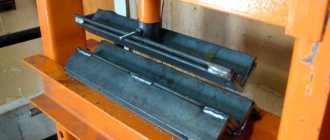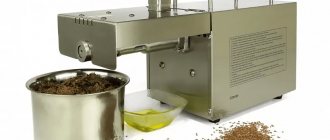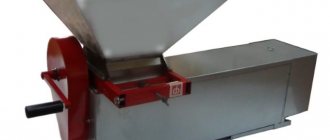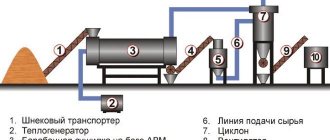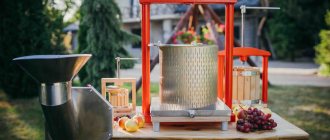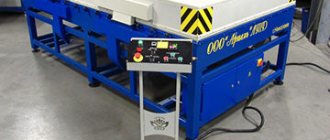Classification
The grape press must be made from environmentally friendly materials. In this regard, only wood and steel are used for the production of units. In addition, devices for pressing juice are classified according to their method of operation, design, and performance.
By way of working
Depending on the type of power supply and method of operation, the following types of equipment are used:
- mechanical and manual grape press - suitable for use in private households, you can do it yourself, but squeezing requires physical effort;
- electric unit - can be screw, pneumatic or hydraulic, characterized by high productivity, low physical labor costs, but expensive (about 30 thousand rubles);
- universal press - the peculiarity is that it can process any vegetables, berries and fruits; such a device operates from the mains.
ElectricUniversal
Manual
By material
Equipment for pressing grapes is made of wood or metal:
- Press with a wooden barrel or basket. If it is possible to make a wine press with your own hands, then linden, beech or oak should be used as the material for the basket. These types of wood are durable, dry quickly, and do not crack or warp when dried.
- Metal unit. Structural elements are made of stainless steel, which increases the cost. This press is durable, hygienic, easy to clean and maintain. The contact of grapes with the working elements of the press does not add extraneous odors to the juice.
Made of metal
Made of wood
By volume and power
The productivity of the press is determined by its type, the power of the electric motor and the volume of processed raw materials.
- High-performance units – continuous electric screw presses. They can squeeze up to 5 tons of grapes per hour, their dimensions are: length - 2.2 m, width - 1 m, height - 1.5 m. Motor power 2.2 kW. Such equipment is appropriate for industrial enterprises or winegrowing farms with large volumes of processed material.
- Hydraulic and pneumatic presses are intermittent units. Productivity reaches up to 40 liters of juice from one bookmark. They are used if you plan to make wine regularly or organize craft production.
- For small volumes in the household, it is advisable to use a self-assembled screw grape press. Its performance is determined by individual needs. Devices with basket volumes from 2.5 to 25 liters are manufactured industrially, allowing you to get from 1 to 25 liters of juice in one batch, respectively.
By design
According to their design features, presses are divided into:
- Screw presses are mechanical presses for squeezing grapes with your own hands. The working container is a wooden basket or a perforated metal barrel, into which crushed pulp or whole grapes are placed. The spinning process is carried out by rotating the handle of a pressing element mounted on a screw auger or rod. Screw presses are simple and trouble-free; productivity depends on the size of the basket.
- Jacking – pressing is carried out using a piston (jack). It can be fixed from above, the pressing force, in this case, is supplied to the pressure plate. If the jack is secured from below, then the basket rises to the fixed pressure plate. In either case, the grapes are compressed between the bottom of the basket and the plate. It is convenient to work with such a press without exerting significant physical effort. They are manual, hydraulic or pneumatic.
- Screw - divided into manual and electric. The principle of operation is similar to a meat grinder and lies in the fact that, thanks to the auger, the pulp is mixed relative to the drainage perforated surface and is subjected to active mechanical action. This treatment can crush the seeds and grind the skins of the grapes. Phenolic and nitrogenous substances pass into the wort. A suspension may form in it.
- Lever ones are the most primitive type. A bag of grapes will be placed between the board and the lever hinged to it. Due to the force applied to the lever, the berries are squeezed between the pressing surfaces. Such presses are leaky, labor-intensive, and low-productive compared to jacking and screw machines.
Lever
JackScrew
Screw
Processing grapes for white wine
Pressing grapes with feet, hands, or a crusher is suitable exclusively for red wines. With these processing methods, pulp is obtained, that is, a kind of “porridge” from grape juice, particles of peel, seeds and, in some cases, ridges. For the preparation of white wines, fermentation on the pulp is not carried out. For several reasons. The main one is preserving the color of the drink. The main amount of grape coloring matter is in the skin. If the integrity of the shell is damaged, it passes into the must and provides color to red wines. It would seem, so what? After all, white grapes have a white shell, so even if the berry is crushed along with it, the color should not suffer. And yet he suffers. The wine turns out darker due to oxidative processes, not as sparkling. The taste also suffers, since the shell contains tannins. The wine turns out rougher. Although it is white wines that are famous for being the lightest, most delicate, radiant and fresh. Therefore, they are prepared exclusively from grape juice.
Types of designs: diagrams and drawings
The main thing in the press is a solid base and working mechanism.
Operating principle of the device:
- prepared raw materials for pressing (chopped apples) are placed in fabric bags layer by layer through drainage grids;
- With the help of a mechanism, pressure is lowered from above and presses the juice.
A good press squeezes out 65-70% of the juice, leaving an almost dry pulp. It’s quite possible to make one with your own hands.
Homemade press designs differ in the operating principle of the main mechanism:
- Screw.
- Based on the jack: mechanical and hydraulic.
- Combined.
In the bulk of structures, pressure is exerted from above, but in the combined version, compression occurs in two directions: using a screw mechanism at the top and a hydraulic jack at the bottom.
The juice press consists of the following parts:
- stable bed;
- a quadrangular or cylindrical body, inside of which bags of chopped apples are folded;
- wooden lattices with which the bags are placed so that they do not spread out;
- piston-pressure, directly exerting pressure on the cake;
- jack support;
- working mechanism: screw with handle, mechanical or hydraulic jack;
- bowl-tray
The main body can be:
single perforated: juice will flow through the holes along the walls and through the bottom into the tray;
Screw apple press with single perforated body
- double: a solid casing with a slightly larger diameter is placed on a perforated metal cylinder;
- in the form of a solid metal body with one drain hole at the bottom;
- assembled from wooden slats connected with hoops - a barrel. The walls serve as a drainage grid.
Screw press for apples with a body made of wooden slats There may be no body at all - just a pyramid of wooden lattice frames in a tray with a mouth at the bottom, under which a container for juice is placed.
Hydraulic Frame Press
This design is easy and quick to install. For the bottom plate, you can take a piece of countertop, for example.
Assembling the press
Making your own structure for obtaining grape juice is not as difficult as it might seem at first glance. The algorithm of actions is very simple, but it will require patience, hard work, and in some cases even ingenuity.
The grape press is assembled. All that remains is to place it on the work surface at a slight angle so that the squeezed liquid drains out without any problems, and place any container under the groove to collect the finished juice.
As you can see, you can make a press with your own hands to obtain berry juice quickly and on a budget. After installing the mechanism, you should check the device for functionality. To do this, fill the drum bowl with ripe fruits and start moving the press handle. This activates the work surface intended for crushing berries. The resulting juice will begin to pour out of the holes and flow into the prepared container. The container for collecting grape juice must be made of inert material. It is acceptable to use wooden, enamel bowls or stainless steel containers.
Source
Step-by-step instructions for making it yourself
Before making a wine press with your own hands, you need to decide what material it will be made of. And its working principle. We will consider a screw mechanism, since a lever mechanism cannot be made at home. To make such a design, you do not need to obtain special skills and knowledge.
It is important to use environmentally friendly materials. They should not absorb the squeezed juice
Some craftsmen use improvised means for these purposes, for example, a washing machine drum, a car jack, an old wooden barrel or a beer keg. Of course, you can specifically buy new materials.
What you need
There are several basic press options. Let's look at one of them. It will require:
- Capacity. Made from wooden planks. You will need 20 pieces, 320-350 mm high, 45-55 mm wide, 15 mm thick.
- Metal plates for making a tightening hoop and fastening. A metal thickness of 0.5 mm to 1 mm will be sufficient.
- Screw.
- Jacking mechanism.
- Pressing plane. The piston can be made of wood or plastic.
- Tray for collecting juice. You can take a regular plastic basin.
- Fastening elements. Bolts, angles, screws.
A minimum set of tools will be required.
When assembling, you need to have a set of plumbing tools:
- screwdrivers, screwdriver;
- hammer;
- hacksaw for metal and wood;
- pliers;
- a set of spanners or open-end wrenches;
- roulette.
Step-by-step instruction
The design will remain unchanged, but some of its elements may have different appearance or features. However, the assembly instructions will remain almost unchanged.
To begin with, a description of the assembly of the classic version. Afterwards we will look at the differences between the others.
The press is assembled from wood as follows.
- The planks are laid out in a row. Strips of metal are placed on top and bottom of them. Using self-tapping screws, the metal is fastened to the board, and you need to leave a distance of 10-12 mm between the boards. Having thus attached all the planks, the structure is rolled up, and the ends of the stainless steel strips are fastened with bolts. It turns out to be a basket.
- We measure its internal diameter. And according to this size we make a piston (punch). It can be made of wood by cutting out a circle of the required diameter. Be sure to leave a gap between the edges of the piston and the basket. The diameter of the circle will be less than the inner diameter of the basket from 1 to 2 cm.
- The pressure on the piston will be applied using a screw and a handle.
- The body (frame) is assembled from metal plates or wooden blocks according to the actual dimensions of the structure. We fasten all parts using bolted connections or welding. A pallet is placed in its lower part, a basket is placed on it and the berries are placed in it. A piston is placed on the berry. A hole is made in the pan, and a tube is attached to it to drain the juice.
- A screw with a handle is fixed in the press body and its lower end rests against the piston. The installation is now complete.
Car jack
Instead of a screw with a handle, you can use a car jack. It is installed in the upper part of the unit, placed on the piston, and its upper part rests against the frame. Otherwise everything is unchanged.
A simple diagram of a press.
Made of stainless steel
Sometimes a basket is made from stainless steel. In this case, take a ready-made container or adapt a drum from a washing machine. The process of making a basket will be more complicated and special equipment will be required.
The tanks are cut, two cylinders are made from stainless steel sheets. The seams are welded. We get 2 cylinders with different diameters - 23 and 29 cm in diameter. Holes are drilled in the walls of a container with a diameter of 23 cm in a checkerboard pattern for better collection of juice; it will be used as a basket. The second container is used to collect juice.
There are two options. The bottom of the cylinder can be welded and the tube removed. Or the structure can also be placed in a basin. Or make a special pallet. In such a tray, you can bend the side on one side and drain it.
As a punch, you can use a flange with a diameter of 21 cm.
From a beer keg
This option is slightly different. The top of the keg is cut off, and a tube comes out of the bottom. The keg will need to be processed so that there are no sharp edges or burrs left.
Step-by-step winemaking
To make wine from grapes at home, use a simple recipe that does not require special conditions, but guarantees a good result.
Stage 1
We leave the pulp obtained by squeezing in the same container.
: do not fill it more than 2/3 full! The pulp rises and fills with carbon dioxide very quickly, which increases the volume, and we don’t want the future wine to run away.
Be sure to cover the container with a cotton cloth and secure it along the edge of the dish so that there is not a single gap left. This is to protect the must from midges and other insects getting inside, which leads to souring of the product and we will not get high-quality wine.
The air temperature at the site of initial fermentation is 18-23°C. That is, the pulp should be kept indoors. If the temperature is above 23°C, then this may not justify the hopes and efforts spent and you will not get wine, but vinegar, which is also needed in the household. However, we have a different goal! If it is colder than 18°C, the fermentation process may not begin.
Advice from experienced winemakers!
The grapes are often expected to ripen completely. This improves the taste of the future wine, but the weather may already be cool when harvesting. Therefore, after bringing in cold grapes from the street, give them several hours to warm up to room temperature. Then start turning it into pulp!
So, the pulp from which we will make homemade red wine is prepared, now we leave it in relative peace. We touch it only once a day - to mix the pulp. Otherwise it may turn sour. We monitor how intensively the formation of carbon dioxide occurs - this is the work of live yeast that was on the surface of the berries.
The pulp rises, and the juice becomes more and more. This indicates that it is time to proceed to the next stage, the appearance of pulp - only skins remain from the crushed berries, the juice has already drained from them. The process takes from 3 to 5 days.
Sometimes novice winemakers try to use only the juice: it is first squeezed out, and all the pulp (including skins, seeds, remnants of twigs from the bunches) is thrown away. This is the wrong approach.
In order for the future wine to gain full aroma and rich color, experienced winemakers under no circumstances give up the pulp.
It is she who gives a velvety soft aftertaste
which homemade wines have! Moreover, it will be different for each grape variety; wine made from white grapes has delicate notes characteristic only of it, which are not characteristic of red.
Stage 2
After the initial stage of fermentation, the wort is separated from the pulp to make wine from grapes. First, strain it using a colander, squeeze the pulp with your hands, and put it in a separate clean bowl.
- excellent raw materials for making mash and making chacha! Don't neglect this opportunity that comes only once a year!
Then we carry out the second stage using gauze or thick cotton fabric. Pour the resulting (still somewhat cloudy) wort into the bottle, filling it 2/3 (maximum ¾).
To make a home winery work, we close it with a stopper with a tube hermetically mounted in it, which we lower into a jar filled with water.
polyethylene lids of a special design are available for sale.
into which water is poured. The caps are designed to fit both wide and narrow neck bottles. Just make sure that such a plug does not dry out, that is, add water as it evaporates!
Water in a jar with a straw or in a lid-lock initially gurgles intensely, releasing carbon dioxide, then the process becomes less intense, and then stops altogether, which indicates that fermentation is over
! A water seal is necessary to protect the wort from oxygen entering, which will certainly lead to sourness. Without a shutter, it is impossible to obtain high-quality wine.
The function of a water seal is successfully performed by a medical glove.
, put on the neck and secured to it with an elastic band for money. Once the glove is inflated, it is pierced with a needle.
Sometimes it is necessary to make several punctures if the glove inflates excessively. The blowing off of the glove indicates that fermentation is complete.
Stage 3
The third stage of how to make homemade wine is the time to adjust the strength
homemade wine. Despite the controversy on this issue, even to obtain dry wine, in the climate of the middle zone, making homemade wine from grapes requires the addition of sugar.
The fact is that both the varieties growing in our country and the weather itself contribute to the fact that the sugar content of grapes (fructose content) does not exceed 20%, and even then only in sweet varieties. Without compensating for its deficiency, we will end up with a sour and tasteless wine, which not everyone likes.
Types of devices
Before purchasing a press for squeezing grape juice or other fruits and vegetables, you need to carefully study all the varieties of these devices.
All industrial squeezing presses can be divided into the following categories.
Mechanical press
Such a device is a stationary cast-iron base on which a special basket made of wood is installed. This solution has good performance, reasonable price and small dimensions. Many winemakers consider a mechanical device for squeezing fruits and vegetables to be the ideal solution for creating juice at home.
Electric press
This subgroup includes two more types of press: hydraulic and pneumatic. Such devices are made of excellent quality stainless steel, so the press will not rust. This solution will not add any off-flavors to your juice. A hydraulic press operates using water, while a pneumatic press operates using high air pressure, which is created by a special pump. Both the hydraulic and pneumatic versions of the pump operate only on electric current.
The main advantage of this solution is the high performance of the device.
Universal press
Many people want their device to be able to squeeze juice not only from grapes, but also from any other fruits and vegetables. Universal presses have long established themselves on the market and are in great demand because they can be used to squeeze juice from apples, cherries, oranges and other crops. This significantly expands the possibilities for making juices and wines.
Every winemaker can buy a five-liter device for pressing grapes and use it at home. All press options are similar in function, however, the material from which the structure is made often differs. The most popular are 2 types of devices: a press made of wood and metal.
- The wooden version
is environmentally friendly and does not cause any harm to human health. However, it is very difficult to care for such a device, since after each use you will have to rinse the device very thoroughly and disinfect it. - The metal version
of the device is an alloy of cast iron and stainless steel. If the design is based on metal, then this device will be durable. The press, made of metal, is very easy to use and is hygienic, as it does not impart any unnecessary tastes or odors to the resulting grape juice.
Preparing the material
One of the main components of the future grape press is a deep bowl where the fruits will be placed. In addition to its impressive size, there are other requirements for the container; it must have holes through which the berry juice will pour. Also, the tank must be made of inert material. The role of a bowl for grapes can be perfectly fulfilled by a washing machine drum made of stainless steel. There are already holes of suitable diameter on its surface.
If necessary, existing holes can be expanded using a metal drill.
If you decide on the idea of making a homemade press, first of all prepare the drum:
- remove the rib punches from it (plastic elements will interfere with pressing the berries);
- using a grinder, remove the metal protrusions intended for attaching the ribs;
- Use a grinder to cut off the part of the drum located near the hatch door;
- If there are convexities on the surface of the drum, take a hammer and turn them into concavities.
This way the bowl of the future grape press will be prepared. You can start assembling the structure. To do this, you will need a metal sheet measuring 1 by 1 meter, a metal corner, a heavy cast iron or steel circle, the size corresponding to the diameter of the drum, a threaded rod approximately 0.8 meters long and a smooth metal rod.
Tips for use
The quality of the resulting juice depends on how the grape press is made and how it is operated. Before starting work, the grapes must be washed, sorted, and the berries separated from the bunches; they do not need to be peeled. It gives juice and wine a pleasant bouquet.
Raw materials for pressing:
- whole berries, used for juice production;
- pulp, allows you to fully reveal the aroma of grapes, recommended for obtaining wine materials.
Sequence of actions when working with the press:
- Fix the device motionless on a horizontal, flat surface to avoid displacement.
- Prepare a container for collecting the pulp. This could be a bucket, tank, pan.
- Place a container under the outlet hose or chute into which the juice will drain.
- Place a plastic bag over the piston plate to prevent the piston from rubbing against solid pulp particles. Rotate the handle to set the screw to the top position.
- Cover the inner surface of the press basket with a clean, cold-water-washed, white, coarsely woven cloth (you can use material from flour or sugar sacks). The edges of the fabric should hang over the sides of the basket. This will make it easier to remove the pulp.
- Place pulp or berries in the basket, cover with the hanging corners of the fabric. Place the basket under the piston.
- Tighten the press screw until juice appears. Slowly turn the screw with the handle until significant resistance is felt.
- Stop the rotation of the screw. After a break of 30-60 seconds, start turning the screw again. This technology allows you to most fully open the cell membranes of grapes.
- After the juice stops flowing, use the handle to turn the screw to the top position.
- To better squeeze the grapes, repeat the process of rotating and stopping the screw 2-3 times.
- After the spin is completed, the press screw should be returned to its original position, turning it in the opposite direction.
- Remove the contents of the fabric from the basket. Transfer the pulp into a previously prepared container. Add a small amount of water so that it covers the cake by 1-2 cm. After 3-4 hours, warm the mixture to 65 degrees. This will allow you to extract as much juice as possible. Spin again. It is not recommended to squeeze the pulp more than three times; this leads to the accumulation of suspension in the wort.
- After completing the process, disassemble the device, clean all parts, rinse well, wipe and dry. To wash the basket, regardless of whether it is made of wood or metal, synthetic detergents should not be used. You can use soda or table salt.
- The press should be stored in a dry, ventilated area.
If a wooden basket becomes moldy, it should be washed with cold water and thoroughly brushed. Then you can prepare a solution of sulfuric acid (100 g per 2 liters of water) and wipe the entire surface of the basket with it, using a brush or piece of cloth. After two days, rinse with lye (an aqueous solution of wood ash) to neutralize the acid, then with clean water.
Read also: Simple landscape design for a small area in front of the house
Another way to get rid of mold is to coat the surface of the basket with lime. After two days, clean everything and rinse with water. Then treat the basket with sand and rinse with a solution of ammonia (3 tablespoons per 5 liters of water). If the mold is not old, you can scrape it off with a knife, then steam the basket with oak sawdust. Moldy parts of the press basket should not be washed with boiling water. This will cause the mold to eat into the wood surface.
Professional winemakers distinguish two types of juice used as wine material:
- obtained by gravity;
- isolated by pressing grapes.
How to crush grapes at home
To mash the grapes and get a delicious wine as a result, you should follow certain rules.
We press with our feet
Grapes were crushed by feet even before the advent of mechanical devices. To do this, the fruits were placed in wooden vats, after which they were kneaded with feet. This process could take up to 10 hours a day.
It was believed that it was easiest to squeeze out the maximum amount of juice with the feet. This method helps to crush the berries, release beneficial substances from the peel and clean the pulp.
With your feet you can feel whole fruits and cold areas that negatively affect fermentation.
However, this method has now lost its popularity. The main disadvantage of the procedure is considered to be insufficient hygiene. The method is used by small manufacturers or hobbyists.
Presses and presses
To process a large amount of raw materials, it is worth choosing special devices. The mechanism of operation of the devices is based on the movement of shafts that rotate in different directions. They squeeze the fruits, which leads to the release of juice.
There are different options for crushers, each of which has certain features:
Juicing devices should not be used for wine. Under thermal influence, the structure of the substance is disrupted. As a result, it will not be possible to prepare wine.
Hand tools
If there is little raw material, it is permissible to squeeze it out by hand. Hand tools are also permitted. If you plan to carry out the procedure with your hands, you should wash them well and wear gloves. It is recommended to mash the berries slowly. In this case, your hands should be near the bottom of the container.
It is advisable that the juice does not come into contact with the metal. The exception is stainless steel. Otherwise, there is a risk of deterioration in the taste of the drink and the occurrence of oxidation processes.
It is also permissible to use a wooden rolling pin to prepare the grapes. A pestle would also be a good option.
To speed up the processing process, use a drill or screwdriver with a mixer-shaped attachment. This method does not require any additional equipment. However, in such a situation it is not possible to break all the grapes. Small fragments of ridges penetrate into the pulp with the fruit.
Containers for must and wine
The first thing you need to start equipping a home distillery is purchasing containers in which the wort will ferment, as well as strain and store the wine. It can be:
- Glass bottles,
- Oak barrels and tubs,
- Stainless steel tanks.
Regarding the use of plastic containers and utensils made of other metals for wine production, you need to take into account that wine alcohol tends to acquire the taste of the material from which the container for storing it is made.
Raw material grinding
For this operation there are special crushers for grapes and fruits. These devices can
be
- Manual - for delicate chopping of small volumes of fruits,
- Mechanical - for intensive work and speeding up the process.
Grape crushers can be equipped with a destemmer to separate the branches (ridges) from the grapes.
Pulp pressing
No home wine production can do without separating the juice from the pulp. A press can handle this operation perfectly; it can be manual or mechanical.
- A manual press is a basket for pressed mass with holes, equipped with a mechanical head with handles.
- A mechanical (hydraulic) press is a basket for crushed pulp with a membrane in the center that expands when it is filled with air.
Under the basket of any press there is a tray with a spout for draining the squeezed liquid. After collecting the valuable juice by gravity, the remaining mass is pressed until it is completely squeezed out.
Fermentation and filtration
Wine in fermentation containers should not come into contact with oxygen. Special fermentation tanks
for wort they must be equipped with water seals. They allow carbon dioxide to be removed and protect the wort from air, and also allow you to control the end of the fermentation process. Hydrometers are used to measure the alcohol content of young wine.
Fermentation is followed by a stage of filtration and removal from sediment. The purpose of this stage is to separate the wine from the yeast that has sunk to the bottom of the container, so as not to degrade its quality. For this purpose, such equipment for wine as a filter press equipped with a pump has been created. Passing through the filter board of this apparatus, the wine is cleaned of colloids, microorganisms, mechanical and adsorption particles. The device is equipped with a pressure gauge that controls the fluid pressure. After such filtration, the wine becomes significantly brighter.
Maturing and capping wine
Aging young wine gives it a special taste and aroma, especially if it takes place in oak barrels. Tannins and oak tannins add a unique accent to the overall bouquet of the drink. If the maturation of wine is planned to be carried out directly in bottles, then in-line and vacuum bottling machines have been created for the production of the drink. Their advantage is that during bottling, the contact of the drink with oxygen is minimized, which guarantees its quality.
It is convenient to cap bottles using a special device for securely placing the cork in the neck. These devices, mechanisms and devices greatly facilitate the work of a winemaker in preparing wine at home.
Attention, TODAY only!
Presses and presses
Widespread mechanization and electrification, having raised industry from its knees, gradually reached private households, also coming to the aid of winemakers preparing their wine at home. Today, there are special presses and crushers that help process the grape harvest at home more than a couple of buckets. The structure of the press is a bit like the wringer from old semi-automatic washing machines. The same two rollers, rotating towards each other with the help of a handle, there is a gap between them, the size is much smaller than a grape, but larger than a seed. As mentioned above, the seeds cannot be crushed. The rollers are located at the bottom of a large funnel, into which the grapes enter for processing. By rotating the handle of such a crusher, you can easily crush a large amount of grapes at home to obtain pulp. Of course, the device described is the simplest option that almost anyone can make at home. The most advanced types of crushers are powered and in addition can separate ridges.
Rules of application
Once manufactured, the press can be placed and secured to any support. Before use, the grape crusher must be placed on a flat surface and secured well.
The manual crusher must be installed on a container to collect pulp. To do this, you can use barrels or tanks made of plastic or stainless steel. To obtain juice, berries are loaded into the loading ladle. From there they are poured onto windrows. A strong napkin must be placed at the bottom of the basket, from which the pulp is then removed.
When rotated, the berries are crushed and then turned into a mass like a puree, from which juice comes out. Before loading the berries into the receiving bucket, they are removed from the bunch and washed well. There is no need to remove the skin from the berries; thanks to it, the juice has a pleasant aroma.
After processing the crop, the device should be thoroughly washed and dried to avoid rotting. A homemade press greatly simplifies the work of processing berries, especially when the harvested crop is about 200 kg.
Video about the principle of operation of the grape press:
We bought it in Ukraine, according to an advertisement. It is popularly called a grape press. For ourselves, we defined it as a press for obtaining juice from grapes, or simply a press for grapes. The advertisement for the sale of the press was given by a man who, in Soviet times, did his own tinkering at the factory, like many in those days.
| The design is simple: a hand press, a stainless steel cylinder with holes and a tray with a groove through which the juice flows. |
| True, the press and cylinder turned out to be fairly smeared with some kind of technical lubricant - either grease or something else. And, of course, before pressing the juice, it was necessary to wash it thoroughly. We asked the seller what the press is smeared with and what is the best way to wash it off, since we want to use it to obtain a food product. The seller replied that he himself probably did not know what kind of lubricant was used. For cleaning, I advised taking “Galosha” technical gasoline for degreasing, “Fairy” type dishwashing detergent and alcohol. We didn’t take risks with gasoline; we were afraid that it would be difficult to wash later, so we washed it right away with Fairy, and then with industrial alcohol. The most difficult thing was to wash the threads on the press, which can only be done with a fine brush. |
| Washed and dried. Carefully secured it to the table. And they started squeezing the juice. And since we did not have instructions for its use, and, unfortunately, the Internet was not “at hand,” we mastered the nuances in practice. |
| The first problem was that the piston came off the press; it took a long time and with difficulty to strengthen it, because the hole in the piston for attaching it to the press was not centered. And how they put him on the press in the first place is unclear. |
| The second problem is to secure it so that the press does not move during operation and does not fall. By the way, it weighs more than 10 kg. The cutouts for the bolts on the base are very small. Well, these problems have been solved. We drilled a hole in the center of the piston and secured it to the press. We attached the press to the table, placing washers under the screws. True, they had to make holes in the table, but they didn’t come up with another option. |
| And they began to squeeze the juice from the grapes. The effort, as it turned out, needs to be made unfeminine. At the same time, juice splashes through the holes in the press cylinder when the grapes are crushed, and even grape seeds shoot out, falling into the pan with juice. As we found out later, to prevent this from happening, you need to put the grapes in a canvas bag and then squeeze the juice out of it. |
| Lowering the piston to the very end, when the handle of the press touches the body, you realize that this is not the very bottom. That is, what remains is a “pancake” of grapes 4.5 cm high. And in these 4.5 cm there are even whole berries. |
We crush grapes with our hands
In home winemaking, hands have replaced feet. Industrial volumes were taken over by all kinds of mechanical and then electric presses and crushers. And the small volumes of wine produced at home are handled not without pleasure by the hands that grew their harvest. Doing it right at home is not at all difficult. Several conditions must be met. Firstly - cleanliness. Basins or other utensils intended for this purpose must be thoroughly washed and dried. Of course, if a few drops of water get into the wort, there is nothing to worry about. Some winemakers specifically add water to reduce the acidity of certain grape varieties. It’s just that if you start crushing grapes in a wet basin, this can only mean one thing - they were washed hastily, right there, immediately before crushing. And this washing may not be of very high quality, like everything done hastily. The art of winemaking does not tolerate fuss, and the vessels for pressure and subsequent fermentation of the pulp should be prepared at home in advance, before the grapes are harvested.
Hands and nails should also be clean. Only His Majesty's grapes can and should remain unwashed. I would like to draw attention to the fact that pressing grapes at home with bare hands can lead to allergic reactions on the skin of the hands, accompanied by itching and various rashes. It is better to put sterile medical gloves on your hands for this task - it is both cleaner and safer.
Secondly - time. The grapes should be pressed into wine immediately after picking, after sorting them first. Sorting involves removing rotten and damaged berries, as well as unripe and moldy grapes.
You should not store grapes for a long time before processing them at home, especially in deep containers or plastic bags. This leads to excessive wateriness of the berries, which negatively affects the fermentation process and the taste characteristics of the future drink. Grapes can lie at home in one layer with good air access for some time solely for one reason, so that the temperature of the bunches rises or falls to the optimal 18–20°C. Whether or not to separate the ridges is entirely your choice.
Thirdly, the quality of crushing. During the processing process, every single grape must be crushed. This must be done quickly, without delay. That's all the wisdom regarding pressing grapes with your hands.
Recommendations for obtaining high-quality juice from berries
One of the main recommendations for working with a press is the need to wash the berries before loading. Only after removing them from the bunch and thoroughly washing them in running water, the material is loaded into the apparatus (drum).
Winemakers who are professionally involved in grape cultivation divide it into 2 levels:
- fruit juice obtained by gravity;
- using a press.
In the first case, the liquid is the most valuable, as it is rich in taste and useful substances. In the second option, you can squeeze out the juice in 2 stages, that is, recycle the pulp. For varieties such as Chardonnay, white Muscat, Pinot Noir, secondary processing is not recommended, since the taste characteristics are significantly affected.
Grape wine recipe
1. Harvesting and processing. To ensure that the wild yeast necessary for fermentation remains on the grapes, it is advisable to pick the berries in dry, sunny weather. There should be no rain for at least 2-3 days before.
Only ripe fruits are suitable for winemaking. There is too much acid in unripe grapes, and in overripe berries, acetic fermentation begins, which can subsequently spoil the entire must (squeezed juice). I also do not recommend taking carrion, which gives grape wine an unpleasant earthy taste. Picked berries need to be processed within two days.
Carefully sort the harvested grapes, removing twigs and leaves, unripe, rotten and moldy fruits. Then crush the berries, place the pulp along with the juice in an enamel pan or plastic bowl, filling the container to a maximum of ¾ of the volume. It is better to crush the grapes with your hands so as not to damage the seeds, which contain substances that make the wine bitter. If there are a lot of berries, you can carefully crush them with a wooden rolling pin (pestle).
Wooden fixtures only
Avoid contact of juice with metal (except stainless steel), as this causes oxidation, which impairs the taste. That is why the berries are kneaded with hands or wooden tools, and the pulp (crushed grapes) is placed in an enamel container with a wide neck - a bucket or pan. You can also use food-grade plastic containers or a wooden barrel.
Mechanism components
- frame;
- a tray into which liquid flows;
- the pressing element itself;
- barrel;
- fine mesh;
- spin-intensifying screw.
The principle of operation of the device is simple: berries are loaded in portions, then the screw is turned and juice with pulp is obtained, which passes through the filter mechanism and is separated from the pulp.
In addition to the fact that the crusher squeezes juice, it can also be used to ferment various drinks. Also, the part that presses and the food material are practically not in contact; therefore, heating is minimal, which ensures the safety of all vitamins and nutrients in the drink.
We crush grapes with hand tools
If the volume of raw materials is small, it is recommended to use your hands or hand tools to extract juice. Before crushing grapes with your hands, you must wash them thoroughly and wear rubber gloves. You need to crush the berries without haste, keeping your hands at the bottom of the container.
It is recommended to avoid contact between juice and metal (except stainless steel), as this impairs the taste of the drink and causes oxidation.
You can also squeeze out the juice using a wooden rolling pin or pestle. For a faster processing process, you need to use a drill or screwdriver with a mixer attachment. This method does not require additional equipment, but in this case, not all the grapes are broken, and small parts of the ridges get into the pulp along with the berries.
Features: pros and cons
Homemade presses have advantages . These are price, availability, sufficient production volume for household farming. You can make a press of individual sizes.
But, as it happens, there are also disadvantages . The homemade press is not airtight. This means that the juice comes into contact with air and the oxidation process starts. This affects the final quality of the product.
In terms of build quality and service life, a do-it-yourself grape press is inferior to factory-made analogues.
Isabella – richness of taste
If you want to make wine from Isabella grapes at home, you should know that it is recommended to dilute it with soft water in the following proportion: for 5 liters of pulp, add 12 liters of water.
In addition, to this amount (you get 17 liters of liquid), add 3 kg of sugar in two times. Why does homemade wine from Isabella grapes need to be diluted with water?
This removes the excessive astringency of this grape variety, and in this version homemade Isabella wine acquires a magnificent, incomparable aroma.
A simple recipe for homemade wine from Isabella grapes
I assure you that making this drink at home is not difficult. The main thing is to follow all the proportions, as well as the cooking technology, and you will succeed.
Should I wash grapes or not? No, you don’t need to wash it so as not to wash away the bacteria that are necessary for fermentation. But this does not mean that you can use everything for better fermentation - naturally, spoiled berries must be thrown away.
How to make wine from grapes at home
Source
Homemade grape press: what is it?
The most popular option and easiest to use is a conventional mechanical press. It consists of a container with holes that acts as a filter, and a mechanism with a screw or lever. Operated by hand. This device is easy to use, simple in principle and cheap.
The raw material is poured into the container, and by rotating the screw or lever the piston is lowered. Under pressure, the juice from the berries flows out, passes through the holes and is collected in a tray, while the pulp remains in the container.
